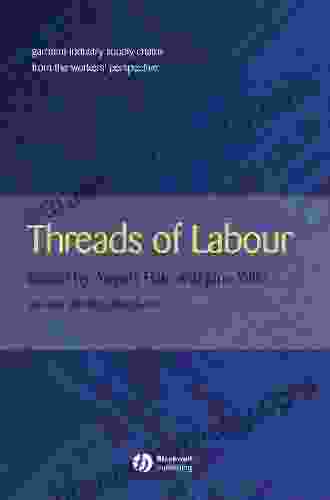Garment Industry Supply Chains: A Workers' Perspective

5 out of 5
| Language | : | English |
| File size | : | 1869 KB |
| Text-to-Speech | : | Enabled |
| Screen Reader | : | Supported |
| Enhanced typesetting | : | Enabled |
| Word Wise | : | Enabled |
| Print length | : | 292 pages |
| Lending | : | Enabled |
The garment industry is a globalized industry with a complex supply chain that spans from the production of raw materials to the manufacturing and distribution of finished goods. The industry is characterized by low wages, poor working conditions, and a lack of transparency. This article explores the garment industry supply chains from the workers' perspective, examining the challenges and opportunities faced by workers in the global garment industry.
Challenges Faced by Workers in the Garment Industry
Workers in the garment industry face a number of challenges, including:
- Low wages: Wages in the garment industry are often below the minimum wage, and workers often have to work long hours to make a living. - Poor working conditions: Working conditions in the garment industry are often dangerous and unhealthy. Workers may be exposed to hazardous chemicals, dust, and noise, and they may be forced to work in cramped and unsanitary conditions. - Lack of transparency: The garment industry is notoriously opaque, and it can be difficult for workers to know who is responsible for their working conditions. This lack of transparency makes it difficult for workers to hold their employers accountable for violations of their rights.
Opportunities for Workers in the Garment Industry
Despite the challenges they face, workers in the garment industry have also made some progress in improving their working conditions. In recent years, there has been a growing movement of workers organizing for better wages, better working conditions, and greater transparency. This movement has had some success, and a number of garment factories have made improvements to their working conditions.
There are also a number of opportunities for workers to improve their skills and knowledge, which can help them to get better jobs and improve their livelihoods. For example, workers can learn about the garment industry, about their rights as workers, and about how to organize for better working conditions.
The Need for a More Sustainable and Equitable Garment Industry
The garment industry is in need of a major transformation. The current system is unsustainable, and it is not fair to the workers who make our clothes. We need to create a more sustainable and equitable garment industry that respects the rights of workers and protects the environment.
There are a number of ways to create a more sustainable and equitable garment industry. These include:
- Increasing transparency: The garment industry needs to become more transparent so that workers know who is responsible for their working conditions. This transparency will make it easier for workers to hold their employers accountable for violations of their rights. - Raising wages: Wages in the garment industry need to be raised so that workers can earn a living wage. This will help to reduce poverty and improve the lives of garment workers and their families. - Improving working conditions: Working conditions in the garment industry need to be improved so that workers are safe and healthy. This includes providing workers with access to clean water, sanitation, and healthcare. - Investing in education and training: Workers in the garment industry need to be given the opportunity to learn about their rights, about the garment industry, and about how to organize for better working conditions. This education and training will help workers to improve their skills and knowledge, which will help them to get better jobs and improve their livelihoods.
The garment industry is in need of a major transformation. The current system is unsustainable, and it is not fair to the workers who make our clothes. We need to create a more sustainable and equitable garment industry that respects the rights of workers and protects the environment.
There are a number of ways to create a more sustainable and equitable garment industry. These include increasing transparency, raising wages, improving working conditions, and investing in education and training. By working together, we can create a garment industry that is fair to everyone.
5 out of 5
| Language | : | English |
| File size | : | 1869 KB |
| Text-to-Speech | : | Enabled |
| Screen Reader | : | Supported |
| Enhanced typesetting | : | Enabled |
| Word Wise | : | Enabled |
| Print length | : | 292 pages |
| Lending | : | Enabled |
Do you want to contribute by writing guest posts on this blog?
Please contact us and send us a resume of previous articles that you have written.
 Book
Book Novel
Novel Page
Page Chapter
Chapter Text
Text Story
Story Genre
Genre Reader
Reader Library
Library Paperback
Paperback E-book
E-book Magazine
Magazine Newspaper
Newspaper Paragraph
Paragraph Sentence
Sentence Bookmark
Bookmark Shelf
Shelf Glossary
Glossary Bibliography
Bibliography Foreword
Foreword Preface
Preface Synopsis
Synopsis Annotation
Annotation Footnote
Footnote Manuscript
Manuscript Scroll
Scroll Codex
Codex Tome
Tome Bestseller
Bestseller Classics
Classics Library card
Library card Narrative
Narrative Biography
Biography Autobiography
Autobiography Memoir
Memoir Reference
Reference Encyclopedia
Encyclopedia James Osiris Baldwin
James Osiris Baldwin Terry Brooks
Terry Brooks Jamie Ward
Jamie Ward Vern Buzarde
Vern Buzarde Maxine Levaren
Maxine Levaren Jane Harper
Jane Harper Julie Gassman
Julie Gassman Michael O Tunnell
Michael O Tunnell Jason Frye
Jason Frye Jazz E
Jazz E Luisa Gastambide
Luisa Gastambide Jan Novak
Jan Novak Jamey Christoph
Jamey Christoph William Reyland
William Reyland Roger J Davies
Roger J Davies Jan Swafford
Jan Swafford Todd Michael St Pierre
Todd Michael St Pierre Jane Drake Brody
Jane Drake Brody James Webb
James Webb Tok Hui Yeap Rd Csp Ld
Tok Hui Yeap Rd Csp Ld
Light bulbAdvertise smarter! Our strategic ad space ensures maximum exposure. Reserve your spot today!

 Darrell PowellThe Ultimate Guide to English Vocabulary and Effective Communication: Unlock...
Darrell PowellThe Ultimate Guide to English Vocabulary and Effective Communication: Unlock...
 Chad PriceValor Child: Children of Valor - The Epic Fantasy Adventure You Won't Be Able...
Chad PriceValor Child: Children of Valor - The Epic Fantasy Adventure You Won't Be Able... Will WardFollow ·10.8k
Will WardFollow ·10.8k Milton BellFollow ·5.3k
Milton BellFollow ·5.3k Earl WilliamsFollow ·18.3k
Earl WilliamsFollow ·18.3k Harold PowellFollow ·4.6k
Harold PowellFollow ·4.6k Rex HayesFollow ·5.5k
Rex HayesFollow ·5.5k Marcel ProustFollow ·10.3k
Marcel ProustFollow ·10.3k Darren BlairFollow ·3.1k
Darren BlairFollow ·3.1k Kenneth ParkerFollow ·11.6k
Kenneth ParkerFollow ·11.6k

 Franklin Bell
Franklin BellHow Businesses Can Thrive In The New Global Neighborhoods
The world is becoming...

 Rob Foster
Rob FosterCard Manipulations Volume 1: A Masterclass in Deception...
Unveiling the...

 Enrique Blair
Enrique BlairUnveil the Secrets of Card Manipulation: Dive into "More...
Step into the captivating world...

 Jamal Blair
Jamal BlairComedy Fillers 200 Quips One Liners Jean Hugard
Unlock the Secrets of...

 Chase Simmons
Chase SimmonsUnlock Financial Independence: A Comprehensive Guide to...
In a world where financial security seems...

 Dion Reed
Dion ReedUnveiling Global Market Entry Strategies: A Comprehensive...
Global Market Entry Strategies:...
5 out of 5
| Language | : | English |
| File size | : | 1869 KB |
| Text-to-Speech | : | Enabled |
| Screen Reader | : | Supported |
| Enhanced typesetting | : | Enabled |
| Word Wise | : | Enabled |
| Print length | : | 292 pages |
| Lending | : | Enabled |








